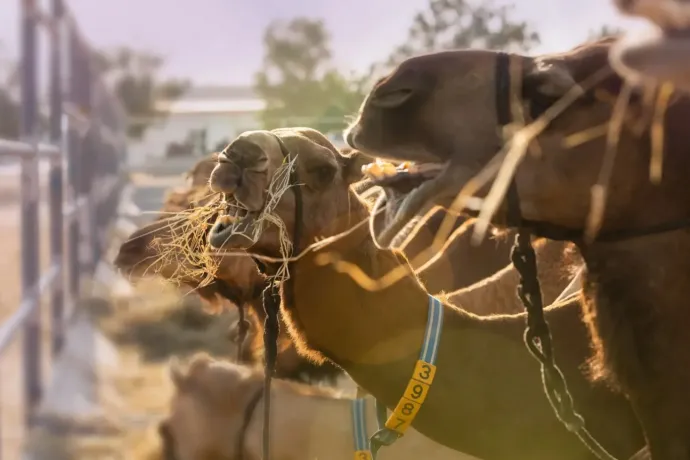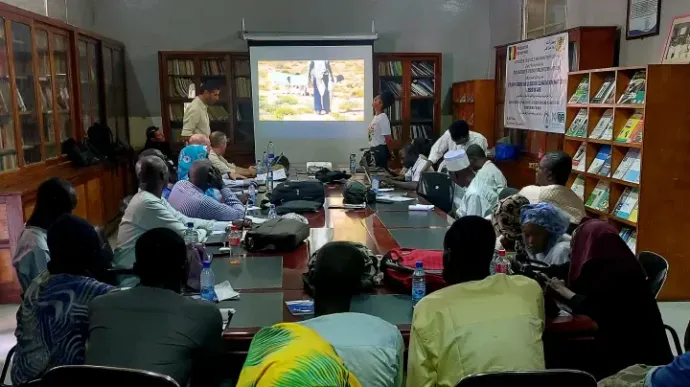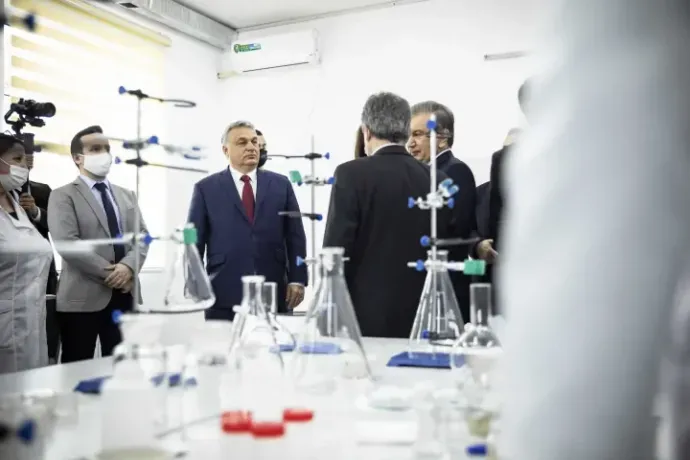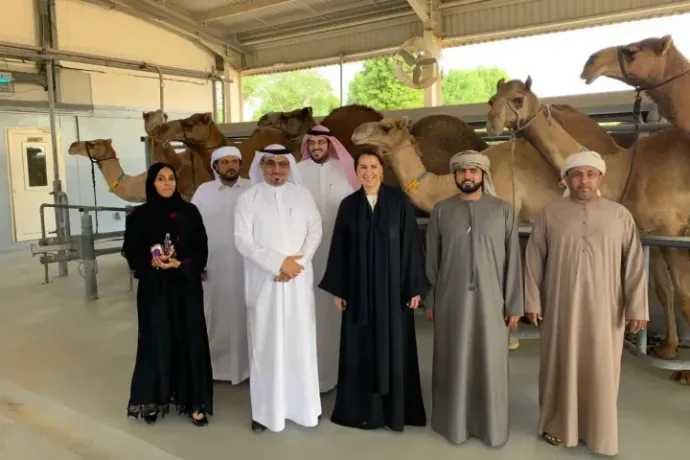
The National Exhibition of Agriculture and the Food Industry (OMÉK) was held last week at Budapest's Hungexpo, where, in addition to displaying agricultural machinery and products of small-scale producers, companies working in the sector and institutions involved in agriculture also set up stands.
Among others, a two-member Kenyan delegation also arrived here on Saturday to discuss the Kenyan demonstration farm which had been announced by Minister of Agriculture István Nagy last March. However, this project is just one of a series of international collaborations launched by the Hungarian University of Agricultural and Life Sciences, (MATE) aiming to open the door for Hungarian agrotechnology companies to distant markets, while also strengthening the institution's own ties in the countries concerned. MATE has also launched a similar partnership in Chad, where it plans to transfer Hungarians' surprisingly extensive knowledge on camels to the Chadians by establishing a center for camel husbandry and camel milk production.
But let's begin with the demonstration farm in Kenya: when it was first announced, the Ministry of Agriculture said that under the project, researchers would be testing seeds and cultivation technologies in the Kenyan town of Mwea. This was not the only project of this kind over the past few years: in 2021, a demonstration farm was established in the Philippines, mainly for rice breeding, followed by a demonstration farm in Chad in 2023, but the Uzbek-Hungarian Potato Research Center, founded in Tashkent in 2021, which at first sounded funny to many, was also established.
The Hungarian University of Agricultural and Life Sciences, which oversees these projects, has other international partnerships as well. For example, they have launched a joint project with Kazakhstan to introduce a variety of Hungarian seeds to the local market. In Azerbaijan, they have established a training center, while in April they held talks with Kyrgyzstan about launching a cooperation in education and innovation.
Exporting technology through local presence
According to Csaba Gyuricza, the rector of MATE, in the 21st century, the emphasis has shifted from selling products to selling the technology itself, meaning that "they are not exporting the screw, but rather building the assembly plant there." Although there have been similar state-supported projects for exporting know-how, according to Gyuricza, it was after MATE's restructuring in 2020 that this type of collaboration really took off. This was when the University of Kaposvár, the Gyöngyös Campus of the Eszterházy Károly University, and the Georgikon Faculty of Pannon University joined MATE, and according to Gyuricza, since then they have succeeded in establishing a presence in more and more countries.
In recent years, quite a number of agricultural cooperation projects similar to those mentioned above have been launched in places which seem relatively far from Hungary. When reading about them, one might well ask: why does Hungary have such projects, and what exactly do the parties involved gain from them?
According to Kennedy Nzioka, who is in charge of the Kenyan demonstration farm, on the one hand, since nearly 60 percent of Kenya's population of 56 million make their living from farming, their goal is to promote types of vegetables and fruits that would yield a higher harvest than the ones currently grown. On the other hand, just as it does everywhere else in the world, global warming is affecting the climate in Kenya too, so they need to prepare for the future with varieties that can withstand more extreme weather than the ones being used right now. A study published by the World Meteorological Organization indicated that Africa is warming up more rapidly than the global average, with the average temperature in 2023 being 0.6 degrees higher than the average measured between 1990 and 2020. In order to prepare for this, they will need to import a variety of plants from abroad that are suitable for the expected local weather conditions.

This doesn’t sound too difficult in theory: the Kenyan delegation looks around abroad, takes home some seeds of different varieties of corn, peppers, and tomatoes, and then sees which ones can produce the most yield. In reality, however, it is a much more complicated process, often requiring the assistance of foreign institutions even in identifying the various local plant species. Moreover, it is not enough to simply plant a seed; it usually needs to be "fine-tuned" through a bit of breeding so that it can adapt to the local environment—and all this is much more difficult to do successfully without the expertise of the researchers who have already been experimenting with the seed in question.
According to László Máthé, chief advisor to the rector of the Hungarian University of Agricultural and Life Sciences, these are the exact things the demonstration farm can provide a platform for, where – under the supervision of MATE researchers – they can examine the seeds and thus determine which Hungarian seeds are best suited to the Kenyan climate.
Additionally, given that the Kenyans may also be looking elsewhere when searching for the most suitable varieties, the fact that – as part of the cooperation – the Hungarians are also offering to help adapt and breed the plants could give them a competitive advantage over seeds from other countries. While the members of the Hungarian research team generally take turns working at the Kenyan demonstration farm, the university staff mostly monitor the project from Hungary.
Africa is a huge market, and it is only going to get bigger
The Uzbek-Hungarian Potato Research Center was a similar endeavour, with the Uzbek side footing the bill for the project. With the Kenyan project, once they have found the Hungarian varieties suitable for the local climate, they will be propagated, and the university may even earn a profit from the license fees for the stecklings sold afterwards. At the Kenyan demonstration farm, MATE negotiated a lease agreement for the plot with a local partner, so there was relatively little infrastructure development required, with the maintenance costs also being covered by the Hungarians. While the costs of the project may also yield a quick return here from the license fees for the stecklings, László Máthé believes that these collaborations may have two even more important benefits.
One of these is that it is relatively difficult for Hungarian companies working in agriculture to take on projects of this size on their own. Additionally, Africa's population is growing rapidly, and according to the World Bank, the number of people living on the continent could reach 2.5 billion by 2050 and 4.5 billion by the end of the century. It is therefore clear that there will be an even greater need for food than before. To this end, the development of agriculture is inevitable in the long term, whether through introducing previously unused crop varieties or improving technologies such as irrigation and fertilization.
All the Hungarian companies working in the field of agricultural technology would be keen to get involved in this potentially lucrative project, but doing so is not that simple: the Hungarian party doesn't always know who to look for in the given market, while the African party may not necessarily trust a company from so far away. This is why a cooperation such as the one conducted by MATE in these countries can be beneficial, as it gives Hungarian companies which are unknown in the relevant market someone to seek guidance from, while at the same time increasing the credibility of the company in the eyes of Kenyan farmers if they come in with the backing of MATE, which has been collaborating with their government.
These projects may thus open up new markets for Hungarian agri-tech companies. For example, during their visit to OMÉK, the Kenyan delegation reached an agreement with a Hungarian company about testing their fertiliser enriched with minerals at the demonstration farm, but according to Kennedy Nzioka, they also held talks with a Hungarian manufacturer of agricultural and industrial drones about potentially using their drones for spraying and inspecting their crops from above. Of course, having a technology tested at a demonstration farm does not automatically mean that the product will become widely used throughout the Kenyan market, but it can be a good starting point, and if it proves to be effective, it will be easier for Kenyan farmers to access it through the Hungarian plants that have been bred and propagated at the demonstration farm.

According to László Máthé, they have recently recorded good results with a variety of watermelon, a hot pepper, and two other types of pepper, so the next step is registering them so that the seeds can be sold on the local market. The cooperation on the Kenyan demonstration farm is due to end at the end of 2025, but the university would like to launch new collaborations with the African country as a continuation of this one.
Although the project is still in its early stages, MATE's plans for the demonstration farm in Chad are even bigger than those for Kenya: last summer, the Hungarian Dairy Research Institute (MTKI), which is affiliated with the university, announced that they would participate in establishing a Center of Excellence for Breeding Camels and Processing Camel Milk in Chad. Under the supervision of MATE, here they will study the handling and processing of camel milk, for which a processing plant will also be built. The foundation stone for the center was laid this summer, and according to László Máthé, construction can begin in November, with the costs being covered by the Hungarian side. The training of Chadian experts has already begun, but the actual work at the facility is expected to start next summer, with its maintenance being financed by the university's local partner, the Chadian Animal Husbandry Research Institute.
Ever since people started recognizing the benefits of consuming camel milk, it has started appearing on the shelves of more and more Western European stores. As it turns out, it contains less saturated fat than cow's milk, and contains more vitamin C and B, and calcium. It can lower the blood sugar level, and according to some studies, it can also help boost the immune system. Another huge advantage is that it doesn't contain lactose, so people who are lactose intolerant may also consume it.
However, due to the challenges of raising camels, its price is much higher. While on average, a cow produces up to 28 liters of milk per day, a camel provides only 2-7 liters. Additionally, it is essential to keep the males around as well, which can increase the price of camel milk to more than twenty times that of cow's milk. In spite of this, the market for this product has been growing year by year, reaching an estimated $14.1 billion in 2023, with some studies predicting an annual growth rate of 9.4 percent through 2030. This might prove especially beneficial for Chad, as the country is home to the world's biggest camel population, with almost 10 million animals living there. The Central African country hasn't really managed to take advantage of this until now, as despite its huge stock of camels, it hasn't even made it into the top five camel milk producing countries.
Incidentally, Chad has received special attention in Hungarian foreign policy in recent years: in November 2023, parliament voted to deploy 200 Hungarian troops to the country which lies on one of the migration routes from Africa to Europe, as part of a military mission aiming to curb the activities of human traffickers facilitating migration. The President of Chad, Mahamat Déby – who took over power from his father in 2021 – was the one who initially approached Hungary with a request to help bolster the capabilities of the Chadian army. This is what eventually led to the planning of the military project with the secret involvement of Viktor Orbán's son. The starting date of the mission is still unknown, however, as Chad suspended negotiations with the Hungarian government in June.
The world's biggest camel farm was set up by Hungarians
It may come as a surprise at first, but the world's largest camel farm, called Camelicious, located on the outskirts of Dubai, was built under the professional guidance of Hungarian researchers. Veterinarians Péter Nagy and Judit Juhász set up the farm, which is now home to around 9,000 camels, in 2006 at the request of the sheikh of Dubai. The researchers have accumulated a wealth of experience and contacts in the industry, so it is also partly thanks to Péter Nagy that MTKI has been awarded some contracts. The institute began its collaboration with Camelicious in 2012, thus acquiring a considerable amount of knowledge in the field of camel husbandry and milk processing over the past 13 years.
They are now looking to export the model used by Camelicious to Chad, where they would assist with both the mechanization of milking and the operation of the equipment used for this, while also providing solutions for the Chadians for both camel husbandry and milk processing. At present, a nomadic form of camel husbandry is typical in the country, where the animals roam and graze freely. The goal now is to transform this traditional form of husbandry into a more systematic, intensive form of breeding, which will also allow for a closer observation and care of the animals. According to László Máthé, with proper husbandry and feeding, the daily milk yield of one camel could be increased to 10-15 liters, but MATE also has plans to breed a herd of camels that produce more milk than the animals currently do. They intend to do this through re-breeding at the demonstration farm.

According to the plans, in addition to income from the sale of camel milk, the center could also generate revenue from selling the animals bred there, while one of MATE's main goals would be to continue its research on camels so that it could then share the knowledge gained with even more countries. According to László Máthé, the experience Hungarian researchers have gained over the last several years is already attracting international attention, and several countries with significant camel populations have approached the university with various proposals for cooperation. In addition to Chad, there could also be joint projects with Kazakhstan and Mongolia in the future. In addition to this, through their new contacts, they would also be able to introduce Hungarian companies to the Chadian market, for example, through the sale of technologies needed for feeding the animals.
According to Csaba Gyuricza, education, research and development, and economic activities tend to be closely linked in agriculture: for example, there are students from 113 different countries at their university, so it is fairly common for students who return home after completing their studies to take up positions that enable them to facilitate cooperation between the two countries.
However, these projects are far from being risk-free, as there is no guarantee that the invested money will pay off in the long run. It may be that even after several years of work, a project will still fail to produce results. Furthermore, the fact that other countries are also engaged in such cooperation may hinder the success of Hungarian technology: Csaba Gyuricza highlighted the Dutch and the Germans at the international level, while regionally it is the Poles who are achieving particularly good results. He also singled out the Japanese and the Chinese as performing well in this respect. These are typically the countries that may be Hungary's biggest competitors, as they are entering the local markets with significant capital and know-how, and often with already developed systems. In such cases, the Hungarian party, operating with less funding, may not be able to compete with them, and its technology may eventually be forced out of the market.
This is why, according to the rector, it is worth taking the opportunity to target various niche markets and focus the cooperation efforts on areas which tend to be overlooked by other countries and in which Hungarian agriculture is fundamentally strong: one example of this could be Hungarian potatoes – which are more drought-tolerant and disease-resistant than their Western counterparts – being cultivated in Uzbekistan. According to László Máthé, in addition to agriculture, water management projects may also be a good entry point into certain African countries, which could then lead to further cooperation in the future.
For more quick, accurate and impartial news from and about Hungary, subscribe to the Telex English newsletter!